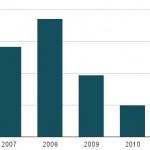Revised Data Show Idaho Didn’t Create Many Jobs In 2012
Data released today by the U.S. Bureau of Labor Statistics show Idaho’s 2012 jobless rate was lower than expected.
The average annual rate was revised down three-tenths of a percent to 7.1. That’s a significant decline from 2011’s average rate of 8.3 percent.
The revised data show the number of jobless Idahoans dropped below 50,000 last year, a first since 2009. Still, the numbers indicate jobs aren’t being created fast enough.
Idaho Labor Department chief research officer Bob Uhlenkott says the labor force here has been mostly flat over the last year.
“That’s still a concern, because in an economic expansion you’d anticipate the labor force would increase, because folks would be more optimistic that there are jobs available out there to get,” Uhlenkott explains. “Now, it’s been confirmed the labor force wasn’t necessarily falling – but it was flat.” He says the concern now is whether Idaho have enough jobs available to drive the state’s economy forward.
Here’s a little context from the Idaho Labor Department:
Idaho’s average unemployment rate for 2011 was 8.3 percent, four-tenths of a point lower than the last estimate, and 8.7 percent in 2010, down a tenth of a point. In contrast, the average rates for 2009 at 7.5 and 2008 at 4.8 were both a tenth of a point higher than the pre-revision averages.
Nationally unemployment averaged 8.1 percent in 2012, 8.9 percent in 2011, 9.6 percent in 2010, 9.3 percent in 2009 and 5.8 percent in 2008. – Idaho Dept. of Labor
It’s also important to consider the kinds of jobs being created in Idaho. Earlier this week, we reported on data that show Idaho has the largest share of minimum wage workers in the country. That’s due in large part to the growth of service-sector jobs, which tend to be low-wage jobs.
Uhlenkott says Idaho’s service sector is seeing more growth thanks to an influx in older people moving into Idaho.
“The bottom line, it’s going to be hard to outpace the service sector because of the aging population,” Uhlenkott says. “It doesn’t mean all those service sector jobs are bad. The aging population will drive health care jobs – we’ve seen an amazing growth in health care, that will continue to grow.”
He adds that Idaho doesn’t want an economy made up only of service sector jobs. Idaho’s economy needs higher paying, technical jobs too.
“The incoming of the older population is naturally driving the service sector. That doesn’t mean goods producing clusters won’t grow, they might grow faster than the national average,” says Uhlenkott. “But relative to the service sector, that’s going to be a hard tide to stem.”


